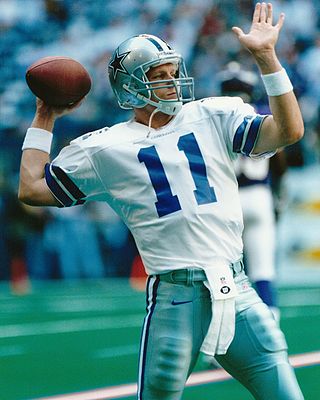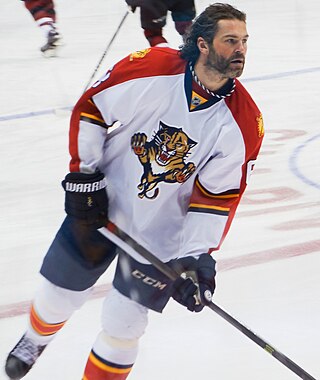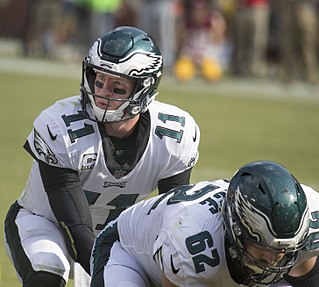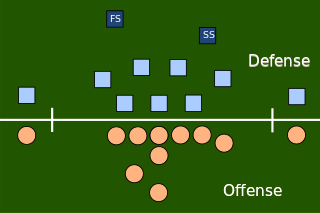
Ice hockey is a team sport played on ice skates, usually on an ice skating rink with lines and markings specific to the sport. It belongs to a family of sports called hockey. In ice hockey, two opposing teams use ice hockey sticks to control, advance, and shoot a closed, vulcanized, rubber disc called a "puck" into the other team's goal. Each goal is worth one point. The team which scores the most goals is declared the winner. In a formal game, each team has six skaters on the ice at a time, barring any penalties, one of whom is the goaltender. Ice hockey is a full contact sport, and is considered to be one of the more physically demanding team sports.

The quarterback, colloquially known as the "signal caller", is a position in gridiron football. Quarterbacks are members of the offensive platoon and mostly line up directly behind the offensive line. In modern American football, the quarterback is usually considered the leader of the offense, and is often responsible for calling the play in the huddle. The quarterback also touches the ball on almost every offensive play, and is almost always the offensive player that throws forward passes. When the QB is tackled behind the line of scrimmage, it is called a sack.

In many team sports, defense or defence is the action of preventing an opponent from scoring. The term may also refer to the tactics involved in defense, or a sub-team whose primary responsibility is defense. Similarly, a defense player or defender is a player who is generally charged with preventing the other team's forwards from being able to bear down directly on their own team's goalkeeper or goaltender. Such positions exist in association football, ice hockey, water polo and many other sports.

In gridiron football, a lineman is a player who specializes in play at the line of scrimmage. The linemen of the team currently in possession of the ball are the offensive line, while linemen on the opposing team are the defensive line. A number of NFL rules specifically address restrictions and requirements for the offensive line, whose job is to help protect the quarterback from getting sacked for a loss, or worse, fumbling. The defensive line is covered by the same rules that apply to all defensive players. Linemen are usually the largest players on the field in both height and weight, since their positions usually require less running and more strength than skill positions.

Winger, in the game of ice hockey, is a forward position of a player whose primary zone of play is along the outer playing areas. They typically flank the centre forward. Originally the name was given to forward players who went up and down the sides of the rink. Wingers generally have the least defensive responsibilities out of any position on the ice, however they are still tasked with defensive duties such as forechecking duties or covering the point in the defensive zone.

Defence or defense in ice hockey is a player position that is primarily responsible for preventing the opposing team from scoring. They are often referred to as defencemen, D, D-men or blueliners. They were once called cover-point.
In sports, a utility player is one who can play several positions competently. Sports in which the term is often used include association football, basketball, American football, baseball, rugby union, rugby league, softball, ice hockey, and water polo.
Strategy forms a major part of American football.

Roller in-line hockey, or inline hockey is a variant of hockey played on a hard, smooth surface, with players using inline skates to move and ice hockey sticks to shoot a hard, plastic puck into their opponent's goal to score points. The sport is a very fast-paced and free-flowing game and is considered a contact sport, but body checking is prohibited. There are five players including the goalkeeper from each team on the rink at a time, while teams normally consist of 16 players. There are professional leagues, one of which is the National Roller Hockey League (NRHL). While it is not a contact sport, there are exceptions, i.e. the NRHL involves fighting.
A formation in American football refers to the position players line up in before the start of a down. There are both offensive and defensive formations and there are many formations in both categories. Sometimes, formations are referred to as packages.

In sports, a starting lineup is an official list of the set of players who will participate in the event when the game begins. The players in the starting lineup are commonly referred to as starters, whereas the others are substitutes or bench players.

Center or Centre (C) is a position in American football. The center is the innermost lineman of the offensive line on a football team's offense. The center is also the player who passes the ball between his legs to the quarterback at the start of each play.

In American football and Canadian football, a quarterback kneel, also called taking a knee, genuflect offense, kneel-down offense, or victory formation, occurs when the quarterback touches a knee to the ground immediately after receiving the snap, thus downing himself and ending the play. It is primarily used to run the clock down, either at the end of the first half or the game itself, to preserve a lead. Although it generally results in a loss of some yardage and uses up a down, it minimizes the risk of a fumble, which would give the other team a chance at recovering the ball.

A halfback (HB) is an offensive position in American football, whose duties involve lining up in the offensive backfield and carrying the ball on most rushing plays, i.e. a running back. When the principal ball carrier lines up deep in the backfield, and especially when that player is placed behind another player (usually a blocking back), as in the I formation, that player is instead referred to as a tailback (TB).

In American football, the specific role that a player takes on the field is referred to as their "position". Under the modern rules of American football, both teams are allowed 11 players on the field at one time and have "unlimited free substitutions", meaning that they may change any number of players during any "dead ball" situation. This has resulted in the development of three task-specific "platoons" of players within any single team: the offense, the defense, and the so-called 'special teams'. Within these three separate "platoons", various positions exist depending on the jobs that the players are doing.

Safety is a position in gridiron football on the defense. The safeties are defensive backs who line up ten to fifteen yards from the line of scrimmage. There are two variations of the position: the free safety and the strong safety. Their duties depend on the defensive scheme. The defensive responsibilities of the safety and cornerback usually involve pass coverage towards the middle and sidelines of the field. While American (11-player) formations generally use two safeties, Canadian (12-player) formations generally have one safety and two defensive halfbacks, a position not used in the American game.
This is a list of common terms used in the sport of ice hockey along with the definitions of these terms.
The forecheck is an ice hockey defensive coverage play made (primarily) in the offensive zone with the objective of applying pressure to the opposing team to regain control of the puck. It is a type of checking. Forechecking is generally executed in one of three situations: recovery of the puck after a dump in, after the rebound following a scoring attempt, or immediately after a turnover to regain possession. Forechecking can be aggressive or conservative depending on the coaching style and on the skating skills of the players.
The following terms are used in American football, both conventional and indoor. Some of these terms are also in use in Canadian football; for a list of terms unique to that code, see Glossary of Canadian football.















